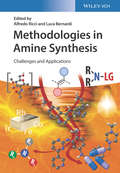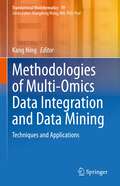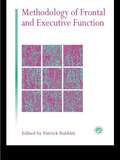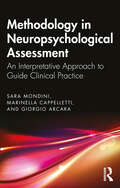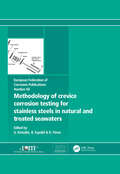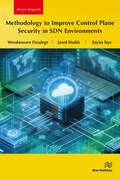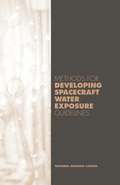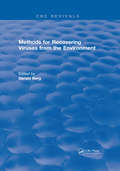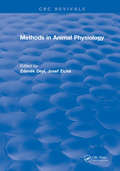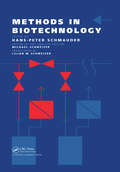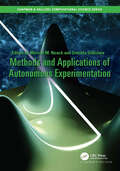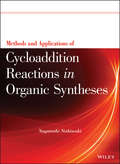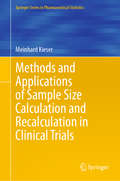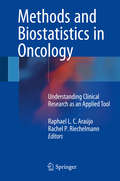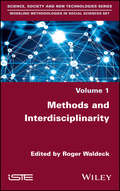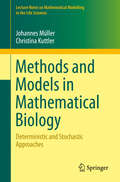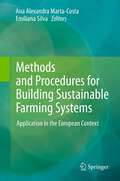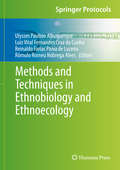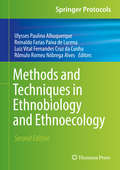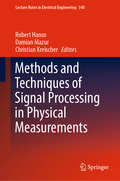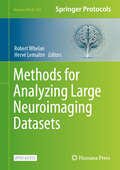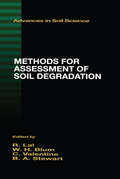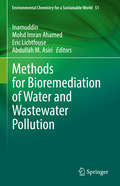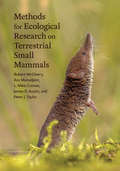- Table View
- List View
Methodologies for Metabolomics
by Norbert W. Lutz Jonathan V. Sweedler Ron A. WeversMetabolomics, the global characterization of the small molecule complement involved in metabolism, has evolved into a powerful suite of approaches for understanding the global physiological and pathological processes occurring in biological organisms. The diversity of metabolites, the wide range of metabolic pathways, and their divergent biological contexts require a range of methodological strategies and techniques. Methodologies for Metabolomics provides a comprehensive description of the newest methodological approaches in metabolomic research. The most important technologies used to identify and quantify metabolites including nuclear magnetic resonance and mass spectrometry are highlighted. The integration of these techniques with classical biological methods is also addressed. Furthermore, the book presents statistical and chemometric methods for evaluation of the resultant data. The broad spectrum of topics includes a vast variety of organisms, samples, and diseases, ranging from in vivo metabolomics in humans and animals, to in vitro analysis of tissue samples, cultured cells and biofluids.
Methodologies in Amine Synthesis: Challenges and Applications
by Alfredo Ricci Luca BernardiProvides a unique overview of efficient synthetic routes to one of the most important compound classes in organic and pharmaceutical chemistry! Amines are among the most important compounds in organic chemistry due to their wide occurrence in natural products, drugs, crop protection compounds, and advanced materials. For example, the majority of drugs are amines or contain functional groups derived from amines. Powerful and efficient methods for the introduction of the amino group are therefore of great importance to synthetic chemists in academia and industry. Methodologies in Amine Synthesis: Challenges and Applications presents powerful and state-of-the-art methods for the efficient preparation of amines. It summarizes recent advances in the electrophilic amination reaction, hydroamination, C?H amination as well as newly developed photocatalytic approaches. It further describes organocatalytic and enzymatic routes to the generation of amines under mild and environmentally friendly conditions. In addition, it highlights the relevance of the amino function in bioactive molecules, drugs, and in the engineering of smart materials. Finally, the application of palladium-catalyzed aromatic amination in industrial context is critically discussed. Only up-to-date and comprehensive book on the preparation of amines ? one of the most frequently occurring compound classes found in natural products, bioactive molecules, and advanced materials. Presents efficient and useful synthetic methods, highlights opportunities / challenges as well as applications in pharmaceutical chemistry and materials science. Chapters are compiled by well-known experts in the field. One of them edited the previous books Modern Amination Methods (2001) and Amino Group Chemistry (2007). The book Methodologies in Amine Synthesis: Challenges and Applications is a musthave for chemists in academia and industry working in the field of organic synthesis and catalysis, natural product chemistry, drug synthesis and pharmaceutical chemistry, as well as materials science.
Methodologies of Multi-Omics Data Integration and Data Mining: Techniques and Applications (Translational Bioinformatics #19)
by Kang NingThis book features multi-omics big-data integration and data-mining techniques. In the omics age, paramount of multi-omics data from various sources is the new challenge we are facing, but it also provides clues for several biomedical or clinical applications. This book focuses on data integration and data mining methods for multi-omics research, which explains in detail and with supportive examples the “What”, “Why” and “How” of the topic. The contents are organized into eight chapters, out of which one is for the introduction, followed by four chapters dedicated for omics integration techniques focusing on several omics data resources and data-mining methods, and three chapters dedicated for applications of multi-omics analyses with application being demonstrated by several data mining methods. This book is an attempt to bridge the gap between the biomedical multi-omics big data and the data-mining techniques for the best practice of contemporary bioinformatics and the in-depth insights for the biomedical questions. It would be of interests for the researchers and practitioners who want to conduct the multi-omics studies in cancer, inflammation disease, and microbiome researches.
Methodology Of Frontal And Executive Function
by Patrick RabbittThis volume reflects the pressure to develop useful models and methodologies to study executive behaviour - the ability to update information in working memory in order to control selective attention to formulate plans of action and to monitor their efficient execution. Many models are based on the concept of a single "central executive" that manges these functions; others propose a number of independent "working memory systems" that each serve one task or activity but not others.; This book is a collection of essays by active researchers who discuss their own work on the definition of "executive" or "controlled" behaviours, and on the relation of these behaviours to specific areas of the frontal cortex. The papers are particularly concerned with logical difficulties that arise in defining these functions that lead, in turn, to methodological difficulties in studying them. In particular, they discuss such problems as the low test-re-test reliability of tasks that have been used to define and explore "executive" behaviours, the limited validity of these tasks in predicting performance deficits, the poor localization of the changes observed with respect to underlying brain function, and the relation of performance on these tasks to individual difference in performance on measures of "global" or "general" intellectual ability such as Spearman's 1927 gf.; The authors discuss their own research on the relations between cognitive function and neuropsychology, on changes in executive competence in conditions such as closed head injuries or dementias that may diffusely affect the whole brain, and on changes in executive function in normal old age.
Methodology in Neuropsychological Assessment: An Interpretative Approach to Guide Clinical Practice
by Sara Mondini Marinella Cappelletti Giorgio ArcaraMethodology in Neuropsychological Assessment: An Interpretative Approach to Guide Clinical Practice provides practical and methodological guidance for neuropsychologists working with people with brain lesions or brain dysfunctions. The textbook underlines the principles that can be used to guide clinicians in recognizing and interpreting signs and symptoms while enabling a complete neuropsychological assessment through a series of well-defined steps. The text provides a detailed methodological approach towards neuropsychological tools, with guidance on how to select the right test and how to interpret the outcome, which can act as a primer for a clinician through every step of the assessment in a coherent and reasoned way. The textbook presents an exhaustive discussion of the varied tools that a clinician can employ to complete a rigorous and consistent neuropsychological assessment. It guides the reader from the first step of collecting the personal history of the examinee – the anamnesis – to the selection of suitable psychometric tests and scoring, which is accordingly integrated to formulate the neuropsychological diagnosis and write up the neuropsychological report. Chapters also include coverage of the neuropsychological interview with the examinee and their family and the probability of identifying a disorder with a neuropsychological assessment. The authors have further included a series of detailed and explanatory clinical cases from their experience to expand upon the evaluation process. The textbook is valuable reading for students in clinical neuropsychology who are learning to carry out neuropsychological evaluations as well as clinicians who are seeking to develop a more comprehensive approach towards performing a thorough neuropsychological assessment.
Methodology of Crevice Corrosion Testing for Stainless Steels in Natural and Treated Seawaters
by Ulf KivisakkThis book describes the work performed to develop a new test methodology to characterise the susceptibility of stainless steels to crevice corrosion in natural and treated seawaters. It also describes the experimental procedures to perform crevice corrosion testing.
Methodology to Improve Control Plane Security in SDN Environments
by Wendwossen Desalegn Javed Shaikh Bayisa TayeThis book unveils a blueprint for safeguarding the very backbone of modern communication networks. It offers a roadmap towards fortifying SDN infrastructures against the relentless onslaught of cyber threats, ensuring resilience and reliability in an ever-evolving digital landscape.This is an exhaustive study of crafting a robust security solution tailored for the SDN environment, specifically targeting the detection and mitigation of distributed denial of service (DDoS) attacks on the control plane. The methodology hinges on an early detection strategy, meticulously aligned with industry standards, serving as a beacon for professionals navigating the intricate realm of implementing security solutions. This reference elucidates an innovative approach devised to identify and mitigate the inherent risks associated with the OpenFlow protocol and its POX controller. Validated through rigorous simulations conducted within controlled environments utilizing the Mininet tool and SDN controller, the methodology unfolds, showcasing the intricate dance between theory and practice.Through meticulous observation of detection algorithm results in simulated environments, followed by real-world implementation within network testbeds, the proposed solution emerges triumphant. Leveraging network entropy calculation, coupled with swift port blocking mechanisms, the methodology stands as a formidable barrier against a DDoS attack such as TCP, UDP, and ICMP floods.
Methods For Developing Spacecraft Water Exposure Guidelines
by National Research CouncilUsing the National Research Council's 1992 Spacecraft Maximum Allowable Concentrations guidelines as a general model, this study articulates the principles of developing spacecraft water exposure guidelines. The authors considered the sources of spacecraft water contaminants, the methods of ranking contaminants for risk assessment purposes, the predicted toxicity for humans in space, risk assessment methods, the altered physiological changes and stresses of microgravity, and the exposure guidelines developed by other organizations. No index. Annotation c. Book News, Inc. , Portland, OR (booknews. com)
Methods For Recovering Viruses From The Environment
by Gerald BergThis book argues, that without methods, there can be no research. Effective research requires effective methods, not always easy to come by. The development of methods in environmental virology became a focus of growing interest about two decades ago. Progress has been significant since that time in pure experimental systems, where there are no interferences, consistent high recoveries of viruses from environmental waters has been achievable for some time. In the natural environment, however, in relatively clean waters, substances such as humic and fulvic acids interfere with viral recoveries and average recovery rates probably do not reach 20%. With sewage sludges and shellfish, recoveries are undoubtedly much lower. Yet, even relatively low viral recovery rates have made possible the detection of viral hazards in drinking waters. The hazards that exist are undoubtedly much greater than those demonstrated with the relatively inefficient methods inefficient methods developed thus far. Improving methods, as they are developed in the years to come, will undoubtedly bring the true extent of the hazards into better perspective.
Methods In Animal Physiology
by Zdenek DeylThe aim of the present volume was to give an overview over different available methodological approaches. The specialists may, perhaps, object that in their particular field the level of information is superficial. However, let them look at other chapters in which different approaches are discussed and which, surely, will appear less superficial from the more general point of view. We hope, at least, that crucial references can be traced throughout the book that would enable the readers to go in more detail when desired. It can be traced throughout the book that would enable the readers to go in more detail when desired. It was really one of our ideas to draw the survey of possibilities available. If this can stimulate the readers to use ideas to draw the survey of possibilities available. If this can stimulate the readers to use other methods that those they are routinely using the goals will be met.
Methods In Biotechnology
by Hans-Peter SchmauderProvides a grounding in the experimental techniques applicable to the discipline of biotechnology. The introductory section in the text describes procedures for analysis of inorganic and organic materials, strain maintenance and fundamental experiments in gene manipulation. Other chapters deal with fermentation techniques, purification methods for substances of interest, preparation of microbial sensors and the demonstration of oil degradation by bacteria. The final chapter deals with statistical planning of experiments and scale-up methods.
Methods and Applications of Autonomous Experimentation (Chapman & Hall/CRC Computational Science)
by Daniela Ushizima Marcus M. NoackAutonomous Experimentation is poised to revolutionize scientific experiments at advanced experimental facilities. Whereas previously, human experimenters were burdened with the laborious task of overseeing each measurement, recent advances in mathematics, machine learning and algorithms have alleviated this burden by enabling automated and intelligent decision-making, minimizing the need for human interference. Illustrating theoretical foundations and incorporating practitioners’ first-hand experiences, this book is a practical guide to successful Autonomous Experimentation. Despite the field’s growing potential, there exists numerous myths and misconceptions surrounding Autonomous Experimentation. Combining insights from theorists, machine-learning engineers and applied scientists, this book aims to lay the foundation for future research and widespread adoption within the scientific community. This book is particularly useful for members of the scientific community looking to improve their research methods but also contains additional insights for students and industry professionals interested in the future of the field.
Methods and Applications of Cycloaddition Reactions in Organic Syntheses
by Nagatoshi NishiwakiAdvanced tools for developing new functional materials and applications in chemical research, pharmaceuticals, and materials science Cycloadditions are among the most useful tools for organic chemists, enabling them to build carbocyclic and heterocyclic structures. These structures can then be used to develop a broad range of functional materials, including pharmaceuticals, agrochemicals, dyes, and optics. With contributions from an international team of leading experts and pioneers in cycloaddition chemistry, this book brings together and reviews recent advances, trends, and emerging research in the field. Methods and Applications of Cycloaddition Reactions in Organic Syntheses focuses on two component cycloadditions, with chapters covering such topics as: N1 unit transfer reaction to C–C double bonds [3+2] Cycloaddition of α, β-unsaturated metal-carbene complexes Formal [3+3] cycloaddition approach to natural product synthesis Development of new methods for the construction of heterocycles based on cycloaddition reaction of 1,3-dipoles Cycloreversion approach for preparation of large π-conjugated compounds Transition metal-catalyzed or mediated [5+1] cycloadditions Readers will learn methods for seamlessly executing important reactions such as Diels-Alder and stereoselective dipolar reactions in order to fabricate heterocyclic compounds, natural products, and functional molecules. The book not only features cutting-edge topics, but also important background information, such as the contributors’ process for developing new methodologies, to help novices become fully adept in the field. References at the end of each chapter lead to original research papers and reviews for facilitating further investigation of individual topics. Covering the state of the science and technology, Methods and Applications of Cycloaddition Reactions in Organic Syntheses enables synthetic organic chemists to advance their research and develop new functional materials and applications in chemical research, pharmaceuticals, and materials science.
Methods and Applications of Sample Size Calculation and Recalculation in Clinical Trials (Springer Series in Pharmaceutical Statistics)
by Meinhard KieserThis book provides an extensive overview of the principles and methods of sample size calculation and recalculation in clinical trials. Appropriate calculation of the required sample size is crucial for the success of clinical trials. At the same time, a sample size that is too small or too large is problematic due to ethical, scientific, and economic reasons. Therefore, state-of-the art methods are required when planning clinical trials. Part I describes a general framework for deriving sample size calculation procedures. This enables an understanding of the common principles underlying the numerous methods presented in the following chapters. Part II addresses the fixed sample size design, where the required sample size is determined in the planning stage and is not changed afterwards. It covers sample size calculation methods for superiority, non-inferiority, and equivalence trials, as well as comparisons between two and more than two groups. A wide range of further topics is discussed, including sample size calculation for multiple comparisons, safety assessment, and multi-regional trials. There is often some uncertainty about the assumptions to be made when calculating the sample size upfront. Part III presents methods that allow to modify the initially specified sample size based on new information that becomes available during the ongoing trial. Blinded sample size recalculation procedures for internal pilot study designs are considered, as well as methods for sample size reassessment in adaptive designs that use unblinded data from interim analyses. The application is illustrated using numerous clinical trial examples, and software code implementing the methods is provided. The book offers theoretical background and practical advice for biostatisticians and clinicians from the pharmaceutical industry and academia who are involved in clinical trials. Covering basic as well as more advanced and recently developed methods, it is suitable for beginners, experienced applied statisticians, and practitioners. To gain maximum benefit, readers should be familiar with introductory statistics. The content of this book has been successfully used for courses on the topic.
Methods and Biostatistics in Oncology: Understanding Clinical Research as an Applied Tool
by Rachel P. Riechelmann Raphael. L.C AraújoThis book introduces and discusses the most important aspects of clinical research methods and biostatistics for oncologists, pursuing a tailor-made and practical approach. Evidence-based medicine (EBM) has been in vogue in the last few decades, particularly in rapidly advancing fields such as oncology. This approach has been used to support decision-making processes worldwide, sparking new clinical research and guidelines on clinical and surgical oncology. Clinical oncology research has many peculiarities, including specific study endpoints, a special focus on survival analyses, and a unique perspective on EBM. However, during medical studies and in general practice, these topics are barely taught. Moreover, even when EBM and clinical cancer research are discussed, they are presented in a theoretical fashion, mostly focused on formulas and numbers, rather than on clinical application for a proper literature appraisal. Addressing that gap, this book discusses more practical aspects of clinical research and biostatistics in oncology, instead of relying only on mathematical formulas and theoretical considerations. Methods and Biostatistics in Oncology will help readers develop the skills they need to understand the use of research on everyday oncology clinical practice for study design and interpretation, as well to demystify the use of EBM in oncology.
Methods and Interdisciplinarity
by Roger WaldeckInterdisciplinarity research results from a growing need for multi-perspective methods, and knowledge on complex and multifaceted objects of study. It is not simply scientific research that involves several disciplines, but ultimately, the aim is confronting this knowledge and – if possible – articulating it coherently. Using specific examples, Methods and Interdisciplinarity categorizes the different modes of interdisciplinarity and discusses the mechanisms of hybridization between them. On the one hand, the book shows how the same issue can be treated according to various points of view from several disciplines, which can give rise to complementary or even contradictory knowledge. On the other hand, it illustrates how methods from some disciplines make it possible to articulate the qualitative or quantitative approaches of others.
Methods and Models in Mathematical Biology
by Johannes Müller Christina KuttlerThis book developed from classes in mathematical biology taught by the authors over several years at the Technische Universität München. The main themes are modeling principles, mathematical principles for the analysis of these models and model-based analysis of data. The key topics of modern biomathematics are covered: ecology, epidemiology, biochemistry, regulatory networks, neuronal networks and population genetics. A variety of mathematical methods are introduced, ranging from ordinary and partial differential equations to stochastic graph theory and branching processes. A special emphasis is placed on the interplay between stochastic and deterministic models.
Methods and Procedures for Building Sustainable Farming Systems: Application in the European Context
by Emiliana L. D. G. Soares da Silva Ana Alexandra Marta-CostaShowing how the method of sustainability assessment plays a key role in choosing the best agricultural productive mode, this book guides the reader through the process of selecting, from among the various approaches for building farming systems, the method of decision-making that will result in the most appropriate outcome, given the context. Case studies hail from polities as diverse as Portugal and Canada, Argentina and Lebanon. The work thus offers a valuable critical survey of the assessment methods that account for sustainability and economics, and which have developed considerably in the last two decades. The heterogeneous approaches covered here make this volume appropriate for consultation in a wide variety of social, political and geographical contexts.
Methods and Techniques in Ethnobiology and Ethnoecology
by Ulysses Paulino Albuquerque Luiz Vital Fernandes Cruz Cunha Reinaldo Farias Paiva Lucena Rômulo Romeu Nóbrega AlvesHumans represent just one of many species that constitute the planet's biodiversity. Nevertheless, as the dominant species, humans have been the primary agent of the transformation of natural spaces. Therefore, the study of human interactions, biodiversity, and the environment that surrounds them is a basic tool for understanding the factors that bind human societies to natural resources. Within this context, ethnobiology is a promising discipline that can play a key role as a mediator of dialogue between different academic disciplines and traditional knowledge, a union essential in enabling contextualized and sustainable alternatives to exploitative practices and biodiversity management. "Methods and Techniques in Ethnobiology and Ethnoecology" introduces the basic techniques and methods traditionally used in ethnobiology and ethnoecology. Comprised of 28 chapters, the book covers the different qualitative and quantitative aspects of ethnobiology research methods, as well as methods from natural and social sciences that will be useful to both beginners and senior researchers. Written by internationally renowned experts in the fields, "Methods and Techniques in Ethnobiology and Ethnoecology "is a valuable resource for researchers and students interested in ethnobiology.
Methods and Techniques in Ethnobiology and Ethnoecology (Springer Protocols Handbooks)
by Ulysses Paulino Albuquerque Rômulo Romeu Alves Reinaldo Farias de Lucena Luiz Vital Cruz da CunhaEthnobiology and ethnoecology have become very popular in recent years. Particularly in the last 20 years, many manuals of methods have published the most classical approaches to the subject. There have been, however, many advances in research as a result of interaction with different disciplines, but also due to more recent results, new original and interesting questions.This handbook provides the current state of the art methods and techniques in ethnobiology and ethnoecology, and related fields. This new volume, besides bringing new and original aspects of what is found in the literature, fills some of the gaps in volume one by including the most systematic and extensive treatment of methods and techniques in qualitative research. Along with the various methods covered in the individual chapters, the handbook also includes an extensive bibliography that details the current literature in the field.
Methods and Techniques of Signal Processing in Physical Measurements (Lecture Notes in Electrical Engineering #548)
by Damian Mazur Robert Hanus Christian Kreischer<p>This book discusses selected issues of modern electrical metrology in the fields of sensor technology, signal processing and measurement systems, addressing theoretical problems and applications regarding measurements in electrical engineering, mechanics, telecommunications, medicine and geology, as well as in the aviation and transport industries. <p>It presents selected papers from the XXII International Seminar of Metrology “Methods and Techniques of Signal Processing in Physical Measurements” (MSM2018) held in Rzeszów-Arłamów, Poland on September 17–20, 2018. The conference was organized by the Rzeszow University of Technology, Department of Metrology and Diagnostic Systems (Poland) and Lviv Polytechnic National University, Department of Information Measuring Technology (Ukraine). <p>The book provides researchers and practitioners with insights into the state of the art in these areas, and also serves as a source of new ideas for further development and cooperation.</p>
Methods for Analyzing Large Neuroimaging Datasets (Neuromethods #218)
by Robert Whelan Hervé LemaîtreThis Open Access volume explores the latest advancements and challenges in standardized methodologies, efficient code management, and scalable data processing of neuroimaging datasets. The chapters in this book are organized in four parts. Part One shows the researcher how to access and download large datasets, and how to compute at scale. Part Two covers best practices for working with large data, including how to build reproducible pipelines and how to use Git. Part Three looks at how to do structural and functional preprocessing data at scale, and Part Four describes various toolboxes for interrogating large neuroimaging datasets, including machine learning and deep learning approaches. In the Neuromethods series style, chapters include the kind of detail and key advice from the specialists needed to get successful results in your laboratory. Authoritative and comprehensive, Methods for Analyzing Large Neuroimaging Datasets is a valuable resource that will help researchers obtain the practical knowledge necessary for conducting robust and reproducible analyses of large neuroimaging datasets.
Methods for Assessment of Soil Degradation
by Rattan Lal Winfried E. Blum B.A. Stewart C. ValentinSoil degradation has serious global impacts on agronomic, economic, and sociopolitical conditions, however, statistics regarding the degree of these impacts has been largely unreliable. This book aims to standardize the methodology for obtaining reliable and objective data on soil degradation. It will also identify and develop criteria for assessing the severity of soil degradation, providing a realistic scenario of the problem.
Methods for Bioremediation of Water and Wastewater Pollution (Environmental Chemistry for a Sustainable World #51)
by Eric Lichtfouse Inamuddin Abdullah M. Asiri Mohd Imran AhamedThis book presents advanced techniques for wastewater treatment and the chapters review the environmental impact of water pollution, the analysis of water quality, and technologies for the preservation of water resources. Also outlined in this volume is the bioremediation of heavy metals, dyes, bisphenols, phthalates, cyanobacteria in contaminated water and wastewater. Another focus of this book is the use of natural remediation techniques such as bacterial biofilms and enzymes.
Methods for Ecological Research on Terrestrial Small Mammals
by Peter J. Taylor Robert McCleery Ara Monadjem L. Mike Conner James D. AustinAll the information researchers, students, and practitioners need to conducted innovative, state-of-the-art research on small mammals.Rodents and insectivores constitute the vast majority of mammals on our planet, yet we often overlook the importance of this group. As seed dispersers, prey species, and disease regulators, these animals are critical to the functioning of our ecological systems. While considerable material exists that describes these species, there has been no dedicated guide explaining how to effectively research them—until now. Methods for Ecological Research on Terrestrial Small Mammals is a one-stop resource compiling all the information readers need to conduct state-of-the-art research on small terrestrial mammals across the globe. The authors cover the full spectrum of issues, from capture, handling, identification, reproduction, demography, and taxonomy to behavior, diet, evolution, diseases, movements, morphometrics, and more. They also:• highlight the latest techniques while carefully explaining the tried-and-tested methods needed to conduct rigorous scientific inquiries; • provide step-by-step examples and case studies, demonstrating how the methods discussed can be used in actual research projects; • compare and contrast methodologies, analytical techniques, and software packages, helping researchers determine which pathways and tools will yield the best results for their studies. A comprehensive and invaluable resource, Methods for Ecological Research on Terrestrial Small Mammals is a must-have for any ecologist working on small mammals.

